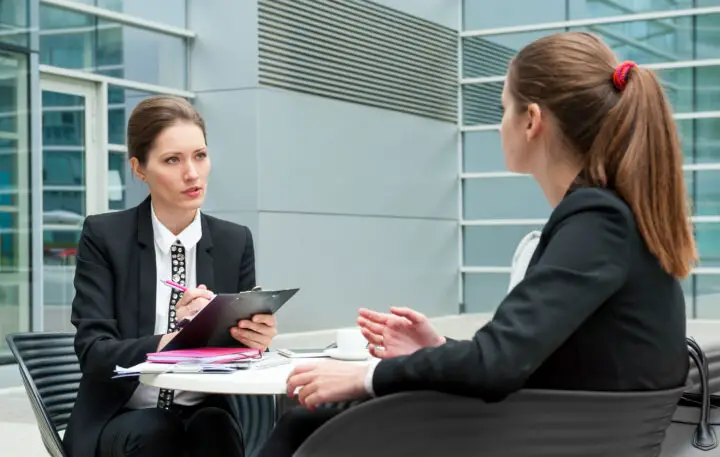The Basics of Body Language for Your Next Job Interview

When preparing for a job interview most people check over their resume, research the company and position, and prepare an appropriate outfit. What most people don’t do, but something that they really should, is to familiarise themselves with the basics of body language and how to utilise these during the interview.
The interview is your first opportunity to make a good impression on your potential employer and a significant part of your ability to do this will depend on your body language.
Interviewers pay close attention to how you look and what you say, but they will also (often unknowingly) judge your body language. According to Business News Daily, our perceptions of other people are made up of 7% the words they say, 38% their tone of voice and 55% their body language.
Understanding the basics of body language will help you to make the best possible first impression. With that in mind, here are the body language basics you should know for your next job interview.
The handshake

A handshake is a basic and polite way to acknowledge another person, but it can also provide a subtle gauge of their personality. Too soft and you could come across as weak or unenthusiastic; too strong and you could be seen as overconfident, aggressive or domineering.
For the perfect handshake, you will need to be firm but careful – like holding a baby. A firm, solid grip, direct eye contact and a polite, friendly smile will set your interview off to a great start.
Keep in mind that it’s polite to wait for the interviewer to initiate the handshake, but they’ll usually do this within the first few seconds of meeting you, so you won’t have to wait for long.
Posture
Make sure you hold good posture from the moment you arrive, as good posture is a clear sign of someone who is relaxed, focused, confident and reliable. Holding good posture is the absolute best way to portray yourself as confident, even if you’re feeling particularly nervous.
Most interviews will take place sitting down, so make sure your back is straight, with your shoulders pulled back and your chin up. Avoid slouching, as this can appear overly casual, disinterested or even arrogant. Sitting up straight in your chair gives an automatic signal of confidence and it is also more polite, as it shows that you are interested and actively listening.
Leaning forward slightly while your interviewer is talking will show that you are engaged, while also appearing more natural than sitting bolt upright.
Smile

A warm, friendly smile can make almost any situation better.
Ross Pike is Marketing Director at Quadrant2Design and an expert in face-to-face marketing and relationship-building. He said “People are naturally drawn to happiness, and smiling is a really simple way to show that you’re a happy, friendly person who’s nice to be around and good to work with”.
At the very least, try to smile as you enter and leave the room so that your first and last impressions are positive, but also smile when your interviewer smiles and in response to any funny comments they might make. This shows that you are friendly and approachable and also highlights that you’re fully engaged with the conversation.
Make sure to keep this natural and appropriate though, as a constant grin throughout the entire interview, or smiling while discussing something sombre can make your interviewer uncomfortable.
Also steer clear of forced, fake smiles as these are instantly recognisable and will arouse suspicion from your interviewer.
Eye contact
Eye contact is simultaneously one of the most important elements of body language and one of the hardest to get right.
Looking your interviewer in the eyes is polite and will show that you are confident and taking everything in, which will subconsciously affirm their confidence in your skills and ability.
If you have more than one interviewer, try to establish eye contact with each of them at some point during the interview. When asked a question, initially make eye contact with the interviewer who asked it then, as you speak, be sure to include the other interviewers and make eye contact with each one for a few seconds.
Try to keep your level of eye contact natural, however, as staring directly at your interviewer for a long time will likely just make them uncomfortable. Also, remember to blink!
Active listening

Active listening shows your engagement and is also a good way of making eye contact less awkward.
It’s common sense not to interrupt your interviewer while they are talking but nodding, tilting your head and smiling when appropriate will all demonstrate your genuine interest and help to avoid staring blankly at your interviewer while they are talking.
Hand gestures
Hand gestures play an important role in effective communication. You might not give it much thought but using hand gestures while you talk can help to show that you are confident in what you are saying and have something important to tell your interviewer.
Simple gestures like touching your fingertips together, moving your fingers while you talk and clasping your palms are good indicators of honesty and openness.
Try to keep your hand movements natural and subtle, as jerky, erratic or frantic movements can be distracting and might suggest that you are anxious or aggressive. Also try to avoid touching your face, head and hair, as this can give the impression of boredom or dishonesty and untrustworthiness.
Fidgeting
Fidgety behaviour like tapping your fingers, picking at your nails and fiddling with your pen can all come across as rude and distracting or suggest that you are feeling nervous or impatient. You can keep your hands busy by taking notes, or gently clasping your fingers together.
Similarly, nervously tapping your hands or feet, continually changing position, or constantly looking around the room will all make you seem anxious and disinterested.
Personal space
Different people can have very different standards of personal space. While one person might be perfectly at ease talking just inches from another person’s face, someone else might need much more space to feel comfortable. If you are told where to sit you won’t have to worry, but if you have a choice of seats, be mindful of the gap between yourself and your interviewer.
Too close and you may make them uncomfortable, too far away and you may seem unapproachable or impolite. A good rule of thumb is to maintain a distance of about 3 feet, but take cues from your interviewer’s body language and move closer or further away as appropriate.
Mirroring

A great way to build rapport and leave a lasting impression is by mirroring your interviewer’s body language. If they nod you can do the same to show that you understand each other and have similar viewpoints. If they use lots of hand movements you can do the same to show the same level of enthusiasm.
It’s really important to keep this subtle though, as there is a fine line between mirroring and copying. If the interviewer scratches their head or crosses their legs and you instantly do the same, this will look unnatural and may even give the impression that you’re mocking them.
Having a good understanding of these body language basics, and putting them into practice, will be an important step in making a success of your next job interview.
Also, read more about your weaknesses in a job interview.
